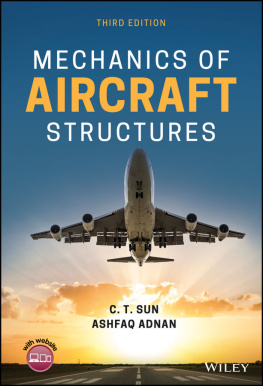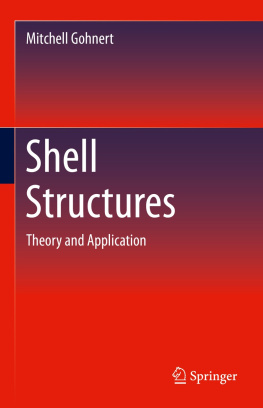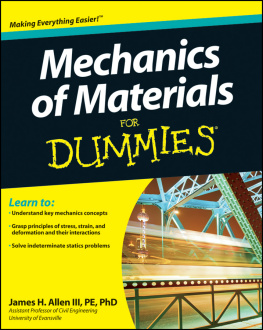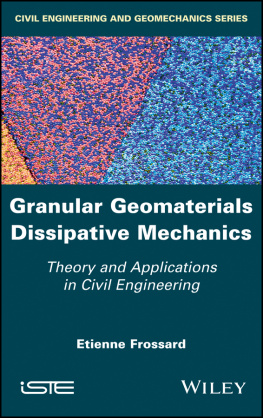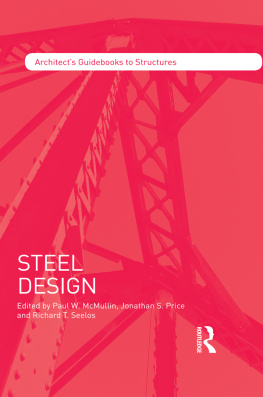The Mechanics of
Engineering Structures
The Mechanics of
Engineering Structures
David W. A. Rees D. Sc.
Brunel University, UK
Published by
Imperial College Press
57 Shelton Street
Covent Garden
London WC2H 9HE
Distributed by
World Scientific Publishing Co. Pte. Ltd.
5 Toh Tuck Link, Singapore 596224
USA office: 27 Warren Street, Suite 401-402, Hackensack, NJ 07601
UK office: 57 Shelton Street, Covent Garden, London WC2H 9HE
Library of Congress Cataloging-in-Publication Data
Rees, D. W. A. (David W. A.), 1947
The mechanics of engineering structures / by David W A Rees (Brunel University, UK).
pages cm
Includes bibliographical references and index.
ISBN 978-1-78326-401-8 (hardback : alk. paper) -- ISBN 978-1-78326-408-7 (pbk. : alk. paper)
1. Structural analysis (Engineering) 2. Mechanics, Applied. I. Title.
TA645.R385 2014
624.1'7--dc23
2013051297
British Library Cataloguing-in-Publication Data
A catalogue record for this book is available from the British Library.
Copyright 2015 by Imperial College Press
All rights reserved. This book, or parts thereof, may not be reproduced in any form or by any means, electronic or mechanical, including photocopying, recording or any information storage and retrieval system now known or to be invented, without written permission from the Publisher.
For photocopying of material in this volume, please pay a copying fee through the Copyright Clearance Center, Inc., 222 Rosewood Drive, Danvers, MA 01923, USA. In this case permission to photocopy is not required from the publisher.
Printed in Singapore
CONTENTS
PREFACE
This book has been compiled from lecture notes and examples that I have used in my teaching of solid mechanics in various forms (including strength of materials, stress and structural analysis), over many years. It is intended for undergraduate and postgraduate engineering courses in which statics, solid mechanics and structures are taught from an intermediary to advanced level. The contents should serve most courses in mechanical, civil, aeronautical and materials engineering. The approach employed is to intersperse theory with many illustrative examples and exercises. As readers work through these it will become apparent what the engineers practical interests in structural mechanics are. They will see that all calculations made are related to a safe load-carrying capacity and the deformation that materials used in structural design undergo. Amongst the specific design considerations are: the choice of material, its physical shape, the nature of imposed loading and its effect on the internal stress and strain. The loadings refer to: tension, compression, bending, torsion and shear. Typical structures upon which these loadings are applied in a multitude of applications include: bars, columns, struts, tubes, vessels, beams, springs and frames.
The chapters follow an orderly sequence, loosely connected to their degree of difficulty, in which the more fundamental material appears first. Thus, the properties of areas, the conditions for static equilibrium, definitions of stress and strain and linear elasticity theory underpin the structural analyses that follow. Therein lie those structures commonplace in many applications: beam bending, torsion of bars and tubes, buckling of struts and plates and tubes under pressure. The final four chapters examine more advanced analytical techniques, including the use of energy methods, plane stress and strain analyses, yield and failure criteria and finite elements. The analyses given of stress, strain, load and deflection employ various techniques with which the reader should soon become familiar. For example, amongst these are: Mohrs circle, the free-body diagram, Hookes law, Macaulays step-function method and Castiglianos theorems. The text illustrates where and how to employ each technique effectively within a logical presentation of the subject matter.
In general, a unique solution to the stress and strain borne by a loaded structure will satisfy three requirements: equilibrium, compatibility and the boundary conditions. Throughout this book these three conditions have been imposed upon many structures to provide closed solutions. However, it may not always be possible to achieve a closed-form solution as the loading and geometry become more complex. The final chapter shows how the known stiffness matrix for simpler types of finite elements can be embodied within a numerical solution to displacement, stress and strain. The three aforementioned conditions are satisfied but, because it is necessary to assume a displacement function, the solutions found remain approximations. Because finite elements cannot improve the accuracy of structural analyses that appear in closed-form the latter are often used to validate the numerical solutions as confidence measure. Finally, it must be mentioned that all that appears in a book of this kind will serve the basic need to design safe structures. The text revisits this basic objective throughout, particularly in its examination of safe stress levels through the use of safety factors. The point is often made that it is only through having a complete grasp of the subject can one exercise a proper control upon the degree of safety required from a structure, especially where the design imposes an economical use of material.
Worked examples and exercise sections have been devised and compiled by the author to support the topics within each chapter. Some have been derived, often with a conversion to SI units, from past examination papers set by institutions with which the author has been associated, namely: Brunel, Dublin, Kingston and Surrey Universities, and the Council of Engineering Institutions (CEI).
D. W. A. REES
HISTORICAL OVERVIEW
I Introduction
The subject of structural mechanics has had a long history within the role it plays in engineering design. Thus it has long been recognised that the engineer needs to design a safe structure, be it a bridge, a pressure vessel, a ship or an aeroplane. Not only is the choice of material important to this goal but also is the correct analysis of the manner in which the external loads are to be supported. It is via this route that a safety factor is decided upon, given other constraints such as minimising weight while retaining stiffness and resistance to corrosion. Solid mechanics is concerned with an understanding of what happens within a body when it is expected to carry loads. We identify the external loads within applied forces, moments and torques and their transmission into an internal stress and an accompanying strain. Often, the subject is employed with a re-design, say in a beam (see ), where the area is to be increased and the length shortened to reduce the maximum stress and deflection to an acceptably safe level for a chosen material. Alternatively, we may select a stronger, stiffer material where an alteration to shape is not permitted if we are to increase the margin of safety. This book shows how mechanics plays an important role within the analysis stage of structures required to bear load often requiring many iterations before the synthesis stage can begin.
A wide variety of structures under different loading modes are presented within the twelve chapters of this book. Throughout the reader will see the names of those men whose contributions to engineering mechanics have shaped the subject into its present form. What follows here is not intended as a detailed biography of each of them, only to recognise that their associations with the following elements of this text has ensured their immortality.
Next page


